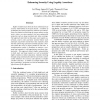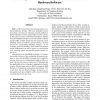5 search results - page 1 / 1 » Repairing return address stack for buffer overflow protectio... |
CF
2004
ACM
13 years 10 months ago
2004
ACM
Although many defense mechanisms against buffer overflow attacks have been proposed, buffer overflow vulnerability in software is still one of the most prevalent vulnerabilities e...
WCRE
2005
IEEE
13 years 10 months ago
2005
IEEE
Buffer overflows have been the most common form of security vulnerability in the past decade. A number of techniques have been proposed to address such attacks. Some are limited t...
ISW
2004
Springer
13 years 10 months ago
2004
Springer
The ICAT statistics over the past few years have shown at least one out of every five CVE and CVE candidate vulnerabilities have been due to buffer overflows. This constitutes a si...
ACSAC
2003
IEEE
13 years 8 months ago
2003
IEEE
Buffer overflow attacks have been causing serious security problems for decades. With more embedded systems networked, it becomes an important research problem to defend embedded ...
CCS
2008
ACM
13 years 6 months ago
2008
ACM
Harvard architecture CPU design is common in the embedded world. Examples of Harvard-based architecture devices are the Mica family of wireless sensors. Mica motes have limited me...


